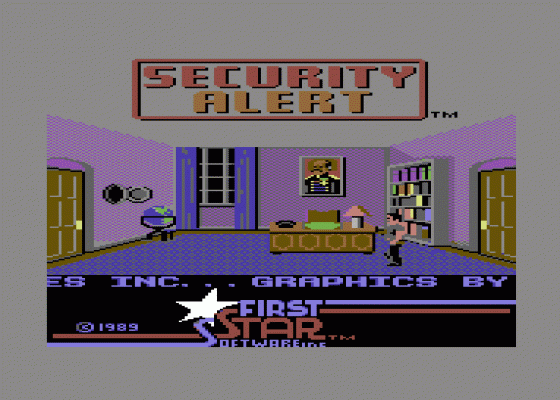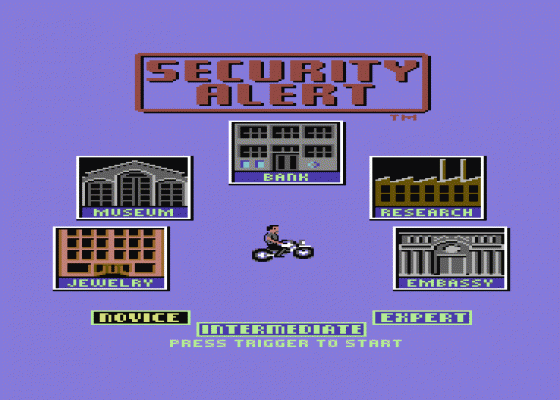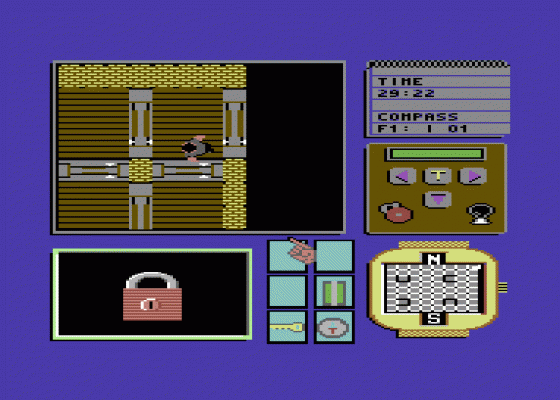
Future Publishing
 1st July 1991
1st July 1991
Categories: Review: Software
Publisher: First Star
Machine: Commodore 64
Published in Commodore Format #10
Security Alert (First Star)
Are you smart enough to rob five top security establishments furbished with the latest in electronic surveillance and protection kit? Okay. Case the joints: there's a jewellery store, a museum, a bank, a research and development set-up and an embassy.
The main game screen is broken up to make it easy (!) for those not accustomed to 'lifting' to tread carefully. The main window tracks your character (and anything else in close proximity). It can do this by showing a plan or side view (some features are more identifiable in one view than in the other). You have to change the view yourself but either way the window displays all animated action.
Moving clockwise around the screen, the next thing you come to is the memo pad, which provides a record of your progress in the game: time, co-ordinates and clues are listed. Below this there's a representation of some of the keyboard. By clicking any of these keys (or their screen copies), not only can the perspective of the main window be altered but the direction of the view can be changed as well. During the game, you constantly have to check in front of you and behind you for devices, guards and so on. Being able to look 'all around' is vital. Just as useful as this panel, and directly below it, is a map which displays the deployment of everyone in the building. Indispensable info for the novice intruder.

Your inventory is a small grid of six boxes which store objects you find along the way; keys, for example. Beneath the main window is the close-up box. It magnifies the image of any object and allows you to tinker with that object. For instance, if you find a safe, get its image into the close up box. You select the appropriate tool from your inventory and move it over to the close-up window. Click once more and watch what happens.
First time through you'll mess up, get caught and have to load the section again. After a couple of tries, you should have a grasp of the controls and a fighting chance of staying out of the guards' way. The more times you're detected the higher the state of alert becomes. If you can lay low for a while, the state of alert is lowered again (but you work against the clock as well).
One of your biggest problems is orientation. One infrared beam might cut across a corridor from wall to wall but another will run from ceiling to floor. You can slide or crawl your way past either of them - but only if you've seen them first.
How do you know when you've succeeded? In addition to loot in general, each 'job' requires stealing a specific item. Without spoiling the plot, Id say it pays to be greedy. The rewards ought to be great anyway: your first games invariably end in the slammer!
The cassette version is crippled by the multiload system. Only once you become competent will you minimalize data loads. And, even then, you can't avoid having to reload a level every time Flakey Lightfinger gets caught. It's just plain unreasonable. But for disk users, Security Alert offers something totally new, scary (if you turn off the lights) and demanding. It's not a game you should expect to get the hang of easily but it's completely different from anything else you're likely to come across. If only the tape version was more accessible, it would have bean a steal.
Good Points
- Completely original game in an unusual style.
- Five different missions to be attempted at three levels of difficulty.
- Loads of traps to overcome.
- Tense, atmospheric and rewarding gameplay for the cunning thief.
- Well devised interface is easy-to-use and gives you all the info you need.
Bad Points
- Tape users will find that crime doesn't pay (thanks to the multiload).
- It really should have had a save game option.
- Initially very difficult to get the hang of (because it's so unusual)
- Graphics and sound effects are very primitive.
Other Reviews Of Security Alert For The Commodore 64
Security Alert (First Star)
First Star is an odd sort of company, on the one hand they're responsible for two classic C64 series: Boulderdash and Spy Vs Spy, yet for long periods of time they release nothing. Security Alert is their latest to bit the UK,
but even it was actually programmed in 1989. Stuart Wynne goes on the rob...
Scores
Commodore 64 Version| Overall | 68% |








